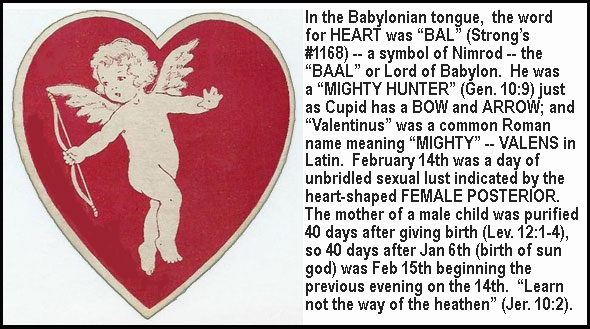
What's Wrong With Valentine's Day?
The True Origins of Valentine's Day
Did you know that centuries before Christ, the pagan Romans celebrated February 15 and the evening of February 14 as an idolatrous and sensuous festival in honor of Lupercus, the "hunter of wolves"? The holiday of romance has roots in an ancient Roman fertility rite known as the Lupercalia. Celebrated on Feb. 15th, the Lupercalia was a fertility rite in honor of the gods Lupercus, Faunus (associated with Pan) and the founders of Rome, Romulus and Remus. The celebration began at the Lupercal cave, where the wolf Lupa was said to have suckled the infant Romulus and Remus. Afterward, priests would sacrifice a goat (symbol of fertility) and a dog (symbol of protection) to the gods, anoint themselves with the blood, and run through the streets whipping females with a thong made from the goat's skin. The whipping was believed to help ease childbirth and promote fertility.
Jeremiah wrote, "Learn not the way of the heathen ... for the customs of the people are vain" (Jer. 10:2). "For the mystery of iniquity doth already work" (2 Th. 2:3,7). "Let no man deceive you by any means; for that day shall not come except there come a FALLING AWAY first" (2 Th. 2:3). "Take heed that no man DECEIVE you. For MANY shall come in my name, saying I am Christ; and shall DECEIVE MANY" (Matt. 24:4-5) -- "speaking PERVERSE things" (Acts 20:30) "and MANY shall follow their PERNICIOUS ways" (2 Pet. 1:2) "turning the grace of God into LASCIVIOUSNESS" (Jude 3,19) "and they shall turn away their ears from the truth, and shall be turned unto FABLES" (2 Tim. 4:3-4).
Also during the festival, young men would draw the names of eligible girls from a pot or urn. These couples would be paired up until the next Lupercalia, often in intimate ways (FORNICATION). A sex orgy. This drawing of Valentine lots continued into the Middle Ages in Europe. The young man would wear the slip bearing his Valentine's name on his sleeve, and attend to the lady with flowers, gifts, and words of affection.
The custom of exchanging valentines and all the other traditions in honor of Lupercus - the deified hero-hunter of Rome- was also linked anciently with the pagan practice of teen-agers "going steady." It usually led to FORNICATION. Today, the custom of "going steady" is thought very modern. It isn't. It is merely a rebirth of an old custom "handed down from the Roman festival of the Lupercalia, celebrated in the month of February, when names of young women were put into a box and drawn out by men as chance directed." That's the admission of the Encyclopedia Americana, article, "St. Valentine's Day."
When Constantine made Christianity the official religion of the Roman Empire there was some talk in church circles of discarding this pagan, lustful, free-for-all. But the Roman citizens wouldn't hear of it! So it was agreed that the holiday would continue as it was, except for the more grossly sensual observances.
Much of the Pagan cultures and traditions were also assimilated and reinvented to fit the Catholic tradition and to attract early pagans to become Christians. In 496 A.D., then Pope Gelasius declared the Lupercalia traditions particularly the love lottery as immoral. The Pope changed the love lottery tradition into a saint lottery where each young boy tries to mimic the qualities of the saint he picks all throughout the year. Pope Gelasius also declared February 14 as the feast of Saint Valentine, the patron of lovers. It was not until the reign of Pope Gelasius that the holiday became a "Christian" custom. "As far back as 496, Pope Gelasius changed Lupercalia on February 15 to St. Valentine's Day on February 14" (p. 172 of Customs and Holidays Around the World by Lavinia Dobler).
But how did this pagan festival acquire the name of "St. Valentine's Day"? And why is the little naked Cupid of the pagan Roman so often associated today with February 14? And why do little children and young people still cut out hearts and send them on a day in honor of Lupercus the hunter of wolves? Why have we supposed these pagan customs in honor of a false god are Christians?
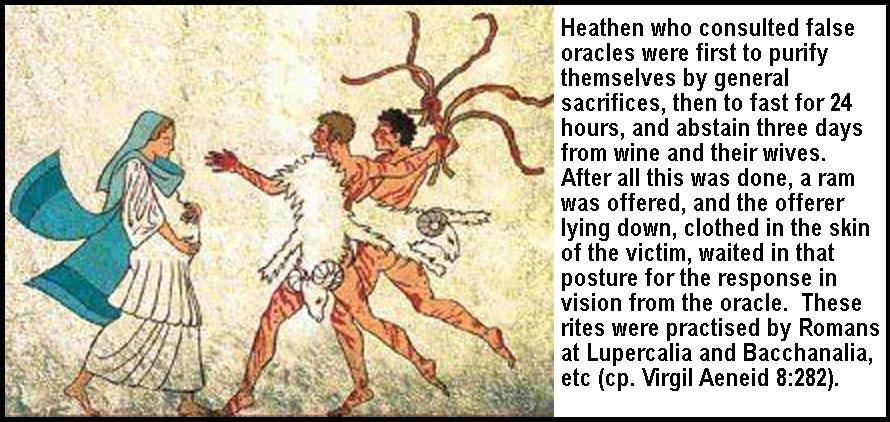
Who Was the Original "St. Valentine"?
Shortly after the Flood, man began to settle in a plain in the land of Shinar (Genesis 11:2). It was in this land that the city of Babylon was built. The Tigris and Euphrates rivers provided fertile soil for the people to grow crops, but it was overrun with wild animals. At this point a powerfully built man by the name of Nimrod came on the scene. “And Cush begat Nimrod: he began to be a MIGHTY one in the earth. He was a MIGHTY HUNTER before the Lord: wherefore it is said, Even as Nimrod the MIGHTY HUNTER before the Lord” (Genesis 10:8-9).
Nimrod’s success as a hunter gained him prestige, and he became a famous leader. He warded off wild animals. To protect the people from this continuous threat, he corralled them into cities with protective walls. This concentration of people increased his power and influence over them. Nimrod’s kingdom became the first mentioned in the Bible (verse 10).
Nimrod was an ungodly ruler; his name in Hebrew simply means “rebellion.” The Jewish Encyclopedia states that Nimrod was “he who made all the people rebellious against God.”
Much of the worship Nimrod established in Babylon was carried out through mysterious symbols. Many of these symbols involved earthly creatures. The Apostle Paul summed up this worship aptly in Romans 1:21-26. To the largely illiterate plebeians of ancient civilizations, symbolism played a major part in their religious worship. Is it any different today?
It is historically well established that the early church of Rome blended pagan beliefs and practices, assigning so-called saints to festivals long previously observed by pagans in an effort to win converts. The church’s decision to alter the festivities by assigning it an acceptable name was based on a third-century account of a presbyter who secretly married couples against the edict of Emperor Claudius ii. Though he was beheaded in 270 A.D., he was later honored as the patron saint of love and lovers, St. Valentine.
But Valentine was a common Roman name. Roman parents often gave this name to their children in honor of the famous man who was first called Valentine in antiquity. That famous man was Lupercus, the HUNTER. Valentinus was a common Roman name derived from the Latin word valens, meaning “to be strong.” Literally Valentinus means “strong, powerful, MIGHTY.”
Authorities, however, agree that this was an ancient, pre-Roman festival handed down from the East. The Encyclopedia Britannica notes that “the festival itself … contains no reference to the Romulus legend, which is probably later in origin ….” The pagan population of Rome observed festivities beginning on the eve of February 14 centuries before the dawn of Christianity.
When Emperor Constantine converted to orthodox Christianity, he was encouraged to break with his pagan past. But the Roman populace of his realm would have none of it. The Christian-professing church decided that the only way to resolve the matter was to let the great masses of the empire (who were now considered members of the church) keep the Lupercalia festival, but under another name and for another purpose.
In the 18th century, English historian Edward Gibbon wrote, “[T]he vestiges of superstition were not so absolutely obliterated, and the festival of the Lupercalia, whose origin had preceded the foundation of Rome, was still celebrated …After the conversion of the Imperial city (Rome), the Christians still continued, in the month of February, the annual celebration of the Lupercalia " (The Decline and Fall of the Roman Empire by Edward Gibbons, Chapter 36, Part 3)
It becomes quite obvious then, that the “Christianization” of Valentine’s Day is rooted in a much older tradition in honor of the “MIGHTY ONE” “who wards off the wolf.”
“After the conversion of the imperial city, the Christians still continued, in the month of February, the annual celebration of the Lupercalia; to which they ascribed a secret and mysterious influence of the genial powers of the animal and vegetable world. The bishops of Rome were solicitous to abolish a profane custom, so repugnant to the spirit of Christianity; but their zeal was not supported by the authority of the civil magistrate: the inveterate abuse subsisted till the end of the fifth century and Pope Gelasius, who purified the capital from the last stain of idolatry, appeased, by a formal apology, the murmurs of the Senate and people” (ibid).
Revelation 17 describes a great counterfeit religion set up by this “mighty one” called: “Mystery, Babylon the Great, the Mother of Harlots and Abominations of the Earth” (verse 5). True Christians are admonished to come out of that religious system (Revelation 18:4). By the time the Apostle John wrote the book of Revelation, the city of Babylon had long been destroyed and left in ruins, but its abominable customs and religious concepts had continued.
The Greeks called Lupercus by the name of "Pan". The Semites called Pan "Baul," according to the Classical Dictionaries. Baal - mentioned so often in the Bible - was merely another name for Nimrod, "the mighty hunter" ( Genesis 10:9) It was a common proverb of ancient time that Nimrod was "the MIGHTY HUNTER before the Lord." Nimrod was their hero - their STRONG man - their VALENTINE!
How plain that the original Valentine was Nimrod, the MIGHTY HUNTER of wolves. Yet another of Nimrod's names was "Sanctuc" or "Santa", meaning Saint. It was a common title of any hero-god. No wonder that the Roman Lupercalia is called "St. Valentine's Day".

Why Hearts?
Thus, February 14th became a day of unbridled sexual lust. The color “red” was sacred to that day be-cause of the blood and the “heart shape” that is popular to this day. The heart-shape was not a representation of the human heart, which looks nothing like it. This shape represents the FEMALE POSTERIOR.
But why do we associate HEARTS on a day in honor of Nimrod - the Baal of the Phoenicians and Semites?
The surprising answer is that the pagan Romans acquired the symbol of the heart from the Babylonians. In the Babylonian tongue the word for HEART was "BAL" (Strong's Concordance Number H1168). The HEART - BAL - was merely a symbol of Nimrod - the BAAL, or Lord of the Babylonians!
According to Young’s Analytical Concordance of the Bible, the word for HEART in the Babylonian language was BEL, or BAL also.
This symbol too would be Christianized by the church in Rome.
Commenting on this symbolism, Hislop asked, “How came it that the ‘HEART’ became the recognized symbol of the Child and the great Mother? … [T]he worship of the ‘Sacred HEART’ was just, under a symbol, the worship of the ‘Sacred BEL,’ that mighty one of Babylon, who had died a martyr for idolatry … the infant god, was regarded as BEL, born again” (op. cit.).
Hislop explored the origin of Cupid (and its Greek equivalent, Eros). He wrote, “[T]his infant divinity was frequently represented with a HEART, or the HEART-shaped fruit of the Persea, on one of his hands …. Thus the boy-god came to be regarded as the ‘god of the HEART,’ in other words as Cupid, the god of love …. To identify this infant divinity with his father, ‘the mighty hunter,’ he was equipped with ‘bow and arrows’ … taking aim with his gold-tipped shafts at the HEARTS of mankind” (ibid).
Knowing that Nimrod was considered the mighty hunter, it is no wonder then that the HEART that commemorates him features so prominently in this festival.
Both Catholic and later Protestant churches retained the pagan trappings and embellishments of the original Roman festival. Hearts continued to be displayed, and lots were still drawn as chance directed. It was also a widely held tradition that the first person of the opposite sex encountered on the morning of St. Valentine’s Day was to become one’s future spouse. At parties people would cast off restraint, often disregarding the inevitable consequences of such lustful revelry.
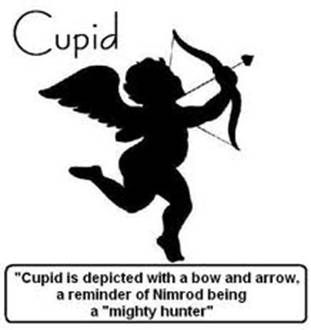
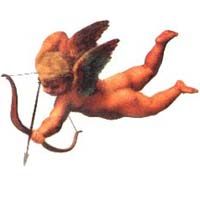
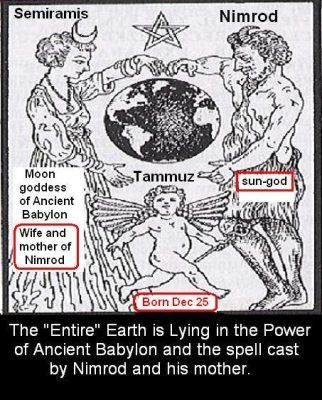
Executed at Rome
Nimrod - the original St. Valentine - was also known as Saturn, the Roman-Babylonian god who hid from his pursuers in a secret place. The Latin word Saturn is derived from the Semitic-speaking Babylonians. It means "be hid," "hide self," "secret," "conceal." The original Semitic (Hebrew) word, from which the Latin Saturn is derived, is used 83 times in the Old Testament (see Young's Concordance under "Sathar," also "sether").
According to ancient tradition, Nimrod was being pursued by bounty hunters who were commissioned by Shem (the son of Noah) to find him and kill him for his many crimes against children. According to the book of Yasher (Jasher), it was Esau (the twin brother of Jacob) who ultimately killed Nimrod. Saturn (Nimrod) fled from his pursuers to Italy. The Apenine mountains of Italy were anciently named the mountains of Nembrod or Nimrod. Nimrod briefly hid out at the site where Rome was later built. The ancient name of Rome, before it was rebuilt in 753 B.C. was Saturnia - the site of Saturn's (Nimrod's) hiding. There he was found and slain for his crimes. Later, professing Christians in Constantine's day made Nimrod - the St. Valentine of the heathen- a Saint of the Church and continued to honor him under the name of a Christian martyr.
Why February 14?
The rites of Lupercalia were directed by a corporation of priests called Luperci. The Luperci began the festival by sacrificing goats and a dog, after which two of the priests approached the altar. They had their foreheads touched with the bloody knife used in the sacrifice and then wiped with wool dipped in milk. The ritual then required that the two young men should laugh. The Encyclopedia Britannica states, “The smearing of the forehead with blood probably refers to human sacrifice originally practiced at the festival.” These priests would cut thongs from the skins of the sacrificed animals and use them to strike people who came near as they circled the city. A strike from one of these thongs, called februa, supposedly prevented sterility in women. The women gladly received the slap, believing that the touch of the februa would render them fruitful and bring about easy childbirth. The name February comes from the Latin februare, meaning “to purify.” The object of the festival was to secure the fruitfulness of the land, the increase of the flocks and the prosperity of the people.
Anciently, it was customary for the mother of a male child to present herself for purification 40 days after giving birth (Lev. 12:1-4).
The winter solstice was celebrated for millennia as the rebirth of the sun, and the birth of the sun god of the ancient pagans, Baal. We have already seen that Baal, Nimrod and Lupercus are all one and the same.
Prior to calendar changes, the winter solstice took place on January 6, instead of on December 25. Counting 40 days from that solstice brings us to February 15. Remember that days in ancient times began at sunset the evening before, and thus celebrations began on the evening of February 14, on Lupercalia, or St. Valentine’s Day.
It was on this day that Semiramis, the mother of Tammuz—the supposed reborn Nimrod—appeared in public for the first time with her son as the original Madonna and child.
Was Cupid the "Desired One"?
In Roman mythology, the goddess of sex, beauty, enticement, seduction and persuasive female charm, Venus, had a son called Cupid. According to the Encyclopedia Britannica, this name means “DESIRE.” (Encyclopedia Britannica, article "Cupid"). Cupid attended his mother on the festival of Lupercalia and was believed to arouse love by shooting arrows at the hearts of the victims. Cupid was generally represented as a winged boy with bow and arrow.
Venus and her son Cupid are simply another iteration of the Madonna and child of the Babylonian mystery religion—Semiramis and Tammuz. After Nimrod’s death, Semiramis is said to have lusted after her newborn son when she saw him. She DESIRED him.So evil was Nimrod's mother that it is said she married her own son! Inscribed on the monuments of ancient Egypt are inscriptions that Nimrod (the Egyptians called him Osiris) was "the husband of his mother." No wonder Cupid’s name means DESIRE.
Valentine’s Day is founded on and saturated with DESIRE and lust. It is only fitting that it is garbed in the symbolism of this original perverted DESIRE of a mother for her son.
As Nimrod grew up, he became the child-hero of many women who desired him. He was their Cupid! In the Book of Daniel he is called the "desire of women" ( Daniel 11:37). Moffatt translates the word as Tammuz - a babylonian name of Nimrod. He provoked so many women to jealousy that an idol of him was often called the "image of jealousy" ( Ezekiel 8:5). Nimrod, the hunter, was also their Valentine - their strong or mighty her! No wonder the pagans commemorated their hero-hunter Nimrod, or Baal, by sending heartshaped love tokens to one another on the evening of February 14 as a symbol of him.
Nimrod, the son of Cush the Ethiopian, was later a source of embarrassment to the pagans of Europe. They didn't want an African to worship. Consequently, they substituted a supposed son of Nimrod, a white child named Horus, born after the death of Nimrod. This white child then became a "fair Cupid" of European tradition.
It is about time we examined these customs of the pagans now falsely labeled Christian. It is time we quit this Roman and Babylonian foolishness - this idolatry - and get back to the faith of Christ delivered once for all time.
Let's stop teaching our children these pagan customs in memory of Baal the sun god - the original St. Valentine - and teach them instead what the Bible really says.

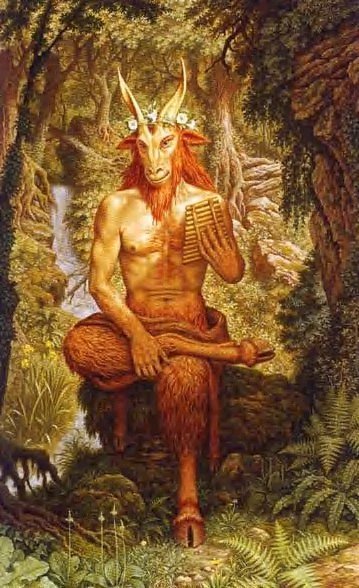
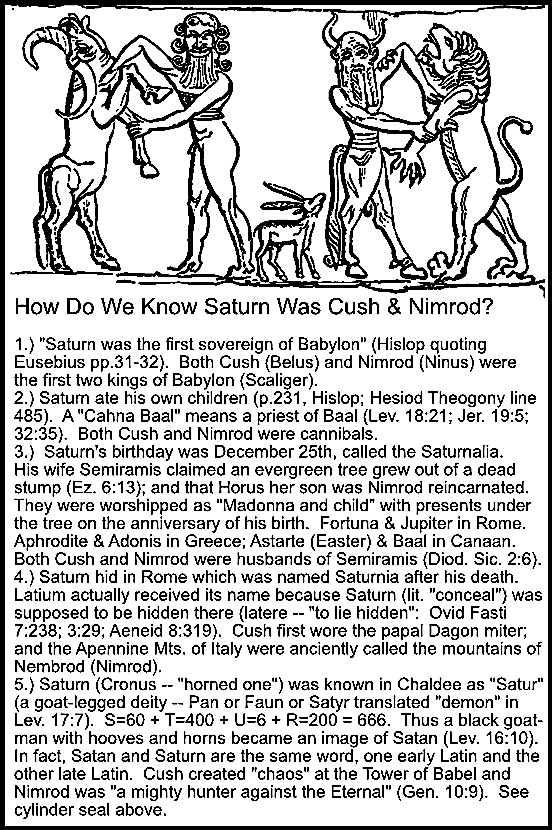
The Horned One
The Encyclopedia Americana, 1996, from the article "Lupercalia," says:
. . . an ancient Roman rite held each February 15 for the fertility god Lupercus. GOATS and a dog were sacrificed, and GOATS' blood was smeared on the foreheads of two young men and wiped off with wool dipped in milk. Young men, wearing only GOATSKIN about their loins, ran around the base of the Palatine hill, striking with GOATSKIN strips any women they met. This was to ease labor for pregnant women and to make the others fertile.
The American Heritage Dictionary, under "Lupercalia," reads, "a fertility festival in ancient Rome, celebrated February 15 in honor of the pastoral god Lupercus." Even the month of February gets its name from this pagan ceremony. The Latin februaue means "to purify" after this so-called "Feast of Purification." Some sources say that the thongs from the skins of sacrificed animals—which the priests used on the evening of February 14 to whip women—were called februa.
Lupercus was the Roman god of shepherds, also known as Faunus, the horned god of the forest, plains and fields who made cattle fertile. Like the Greeks before them, the Romans were well known for their sexual immorality, and the Roman festival of Lupercalia was a particular “love” fest—not based on any principle of outgoing concern, but on perverted lusts and free sex.
The Greek equivalent to Lupercus was the god Pan, the god of fields, groves and wooded glens. Depicted with the hindquarters, legs and horns of a goat, Pan was famous for his sexual prowess and is related to all sorts of sexual perversions such as masturbation and bestiality, which he supposedly taught to shepherds.
Pan, a rustic god, was not worshiped in temples or other man-made edifices, but in natural settings, usually caves or grottoes such as the one on the north slope of the Acropolis of Athens, often referred to as the Cave of Pan.
Also highly prominent during Lupercalia was the she-wolf, Lupa, that, according to legend, suckled the infant orphans Romulus and Remus, the supposed founders of Rome, in the cave of Lupercal on the Palatine Hill (the central hill where Rome was traditionally thought to have been founded).
This connection between the grottoes of Athens and the cave of Lupercal proves that the history of this observance long pre-dated Roman times.
Several elements of this deity can be traced back to ancient civilizations. One of these is the depiction of this deity as a horned god. The first deified king of Babylon—identified as the husband of Rhea, the great goddess mother of Chaldea—was Kronos, meaning “the horned, or mighty one.” Ancient coins depict this king as a centaur archer, intended to perpetuate the memory of his fame as a huntsman.
The similarities with the half-man, half-animal god Pan are obvious. Semites called Pan “Baal,” a name often mentioned in the Bible. Baal, Bel, Nimrod, Tammuz, Kronos, Pan, Lupercus and Valentine are all one and the same. And Valentine’s Day was the day originally set aside by the pagans in his honor. Engaging in it is simply Baal-worship!
The 19th-century author Alexander Hislop states: “The meaning of this name Kronos, ‘the horned one,’ as applied to Nimrod, fully explains the origin of the remarkable symbol, so frequently occurring among the Nineveh sculptures, the gigantic horned man-bull, as representing the great divinities in Assyria. The same word that signified a bull, signified also a ruler or prince. Hence the ‘horned bull’ signified ‘the mighty prince’ …” (The Two Babylons).
Ancient Assyrian carvings often show a horned and winged bull. The mighty kings of Babylon and Assyria imitated Nimrod and his successors. Kronos wore horns as the emblem of both his physical might and sovereign power. In popular superstition, this image has become the recognized representation of the devil.
Going Steady
The custom of exchanging valentines is also linked with the practice of going steady. Young men and women who otherwise lived separate lives in ancient Rome were paired on the eve of Lupercalia. All the young marriageable girls placed a chit of their name in a big urn. Each young man drew out the name of a girl from the urn, and the two would be paired for the duration of Lupercalia. Sometimes the pairing lasted for a year, until the next year’s celebration. Quite often, the couple would later marry. The custom lasted for a long time until people decided that mates should be chosen by sight, not luck.
Laurence Whistler wrote, “It was about the middle of the month that the names of willing young ladies were put in a box and well taken up, so that each young blood could draw out one at random; the girl thus won was to remain his companion while the gaieties lasted” (The English Festivals). This often led to FORNICATION. The festival was “characterized by wanton raillery and unkindly freedom” (Encyclopedia of Religion and Ethics).
Many today seek a steady girl- or boyfriend with the request “be my Valentine.” The note may be delivered via text message instead of a note in an urn, but the intent and tragic outcome are often the same. FORNICATION.
Furthermore, many husbands or boyfriends feel FORCED to give their wives or girlfriends a gift on this day. Gifts of love should be spontaneous and VOLUNTARY. Otherwise women come to EXPECT it.
Be Not Snared
When God set apart ancient Israel as a nation, He warned the people against paganism. “When the Lord thy God shall cut off the nations from before thee, whither thou goest to possess them, and thou succeedest them, and dwellest in their land; Take heed to thyself that thou be not snared by following them, after that they be destroyed from before thee; and that thou enquire not after their gods, saying, How did these nations serve their gods? even so will I do likewise. Thou shalt not do so unto the Lord thy God: for every abomination to the Lord, which he hateth, have they done unto their gods …Whatever I command you, be careful to observe it; you shall not add to it nor take away from it” (Deuteronomy 12:29-32).
“Then it shall be, if you by any means forget the LORD your God, and follow other gods, and serve them, and worship them, I testify against you this day that you shall surely perish” (Deuteronomy 8:19).
Note that the issue in this passage is NOT the worship of other gods. The warning is to not adopt CUSTOMS used to worship or honor other gods in order to serve and worship the true God.
"Therefore shall you keep my ordinance, that you commit not any one of these abominable customs, which were committed before you, and that you defile not yourselves therein: I am the LORD your God" (Lev. 18:30).
The true origin of Valentine's Day and its symbols are rooted in the worship of false gods.
God forbade the keeping of these pagan festivals. In His sight, they are abominations. Not only are these pagan festivals vain and purposeless, observing them blinds us to the real purpose for man’s existence.
Centuries later, God reiterated this warning: “Learn not the way of the heathen … [f]or the customs of the people are vain” (Jeremiah 10:2-3).
Don’t casually shrug off the customs of the society around you, but be sure you know their origins. Take time to examine the world’s foolish customs now falsely labeled “Christian.” See them for what they are: idolatry. Don’t be snared by them!
Since the beginning of human civilization, Satan has used pagan celebrations to keep man ignorant of God’s plan and enslaved to his way. But God has given His people meaningful festivals that reveal His plan of salvation for all mankind (Leviticus 23). God commands us to keep these holy days so we may be free from such utter ignorance and confusion.
| Love looks not with the eyes, but with the mind; And therefore is winged Cupid painted blind. Nor hath Love's mind of any judgment taste; Wings, and no eyes, figure unheedy haste: And therefore is Love said to be a child, Because in choice he is so oft beguiled. |